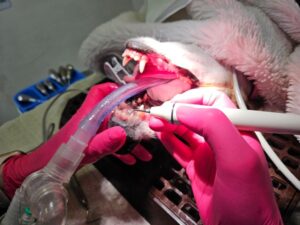
Introduction
Duffy, a treasured rescue lurcher owned by one of our nurses at the Village Vets Stillorgan branch, visited for a Comprehensive Oral Health Assessment & Treatment (COHAT). As a breed predisposed to dental disease, Duffy’s visit for a routine COHAT was essential, particularly considering her unknown age and lack of prior dental intervention. This article explores Duffy’s journey through the COHAT process and the importance of early intervention for dental health in pets.
Examination & Findings

On examination, signs of periodontal disease were evident, with substantial tartar buildup, accompanied by gingivitis and recession affecting her top cheek teeth in particular.
Duffy also has a concurrent heart murmur which increased the anaesthetic risk, necessitating a comprehensive cardiac evaluation with the cardiology vet. The additional information gained from the heart scan allowed the veterinary team to tailor Duffy’s anaesthetic plan accordingly. Once anaesthetised, Duffy underwent a comprehensive evaluation, including full-mouth dental X-rays, allowing us to assess the tooth roots and surrounding bone. There was evidence of slight bone loss and furcation exposure on some of Duffy’s upper cheek teeth indicating periodontal disease which is progressive. These teeth have three roots.

About Furcation Exposure
Furcation exposure occurs due to bone loss in between the tooth roots of multirooted teeth. It can be classified into three stages, with stage 3 being the most severe. At stage 3, the space between the roots is exposed to the point where a probe can be passed through completely from one side to the other. All stage 3 furcation’s must be extracted.

Treatment Plan
Some of Duffy’s teeth had grade 2 furcation (F2). Extraction wasn’t indicated during this procedure and with diligent homecare, including daily brushing, the periodontal disease and bone loss around these teeth can be slowed down, preserving Duffy’s precious teeth. These teeth are multirooted and strategically important teeth so keeping them for as long as possible is beneficial to Duffy.
Dental Procedure
Following the oral examination which included dental charting and evaluation of the x-rays the tartar on Duffy’s teeth was removed using an ultrasonic scaler. Each tooth was scaled above and below the gumline followed by a thorough polishing to ensure a clean, smooth surface. Regular professional cleanings help slow down the progression of the periodontal disease along with creating the optimal starting point for ongoing homecare.

Importance if Early Intervention
The timely intervention of the COHAT allowed the veterinary team to diagnose and treat Duffy’s dental issues early. This proactive dental care has improved the oral health and overall wellbeing of Duffy by reducing the discomfort in her mouth and slowing down the progression of the periodontal disease. With a commitment to ongoing homecare, including daily brushing, Duffy’s long-term oral health outcomes remain optimistic. Early detection and intervention is key in preserving the oral health of pets, particularly those predisposed to dental disease.
Conclusion
Duffy’s journey through the COHAT process highlights the significance of proactive dental care and early intervention in maintaining the oral health of our beloved pets. Through comprehensive examination, tailored treatment plans, and ongoing homecare, pets like Duffy can enjoy healthy smiles and improved overall well-being.




